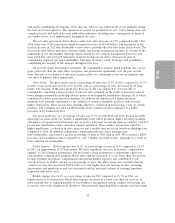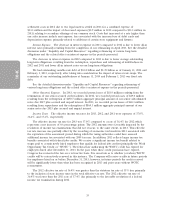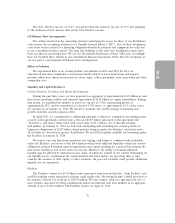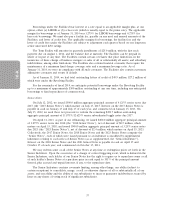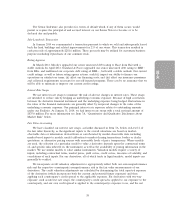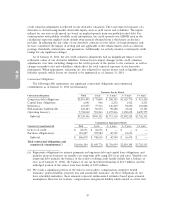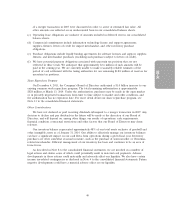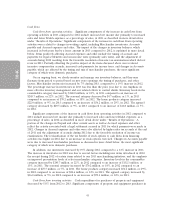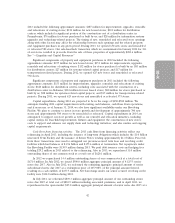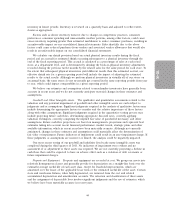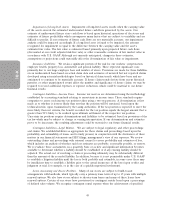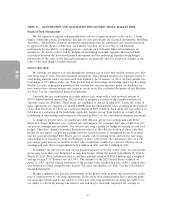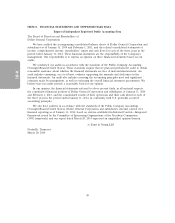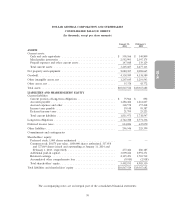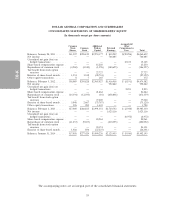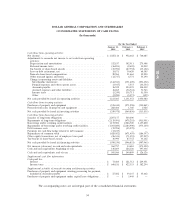Dollar General 2013 Annual Report Download - page 121
Download and view the complete annual report
Please find page 121 of the 2013 Dollar General annual report below. You can navigate through the pages in the report by either clicking on the pages listed below, or by using the keyword search tool below to find specific information within the annual report.
inventory in future periods. Inventory is reviewed on a quarterly basis and adjusted to reflect write-
downs as appropriate.
Factors such as slower inventory turnover due to changes in competitors’ practices, consumer
preferences, consumer spending and unseasonable weather patterns, among other factors, could cause
excess inventory requiring greater than estimated markdowns to entice consumer purchases, resulting in
an unfavorable impact on our consolidated financial statements. Sales shortfalls due to the above
factors could cause reduced purchases from vendors and associated vendor allowances that would also
result in an unfavorable impact on our consolidated financial statements.
We calculate our shrink provision based on actual physical inventory results during the fiscal
period and an accrual for estimated shrink occurring subsequent to a physical inventory through the
end of the fiscal reporting period. This accrual is calculated as a percentage of sales at each retail
store, at a department level, and is determined by dividing the book-to-physical inventory adjustments
recorded during the previous twelve months by the related sales for the same period for each store. To
the extent that subsequent physical inventories yield different results than this estimated accrual, our
effective shrink rate for a given reporting period will include the impact of adjusting the estimated
results to the actual results. Although we perform physical inventories in virtually all of our stores on
an annual basis, the same stores do not necessarily get counted in the same reporting periods from year
to year, which could impact comparability in a given reporting period.
We believe our estimates and assumptions related to merchandise inventories have generally been
accurate in recent years and we do not currently anticipate material changes in these estimates and
assumptions.
Goodwill and Other Intangible Assets. The qualitative and quantitative assessments related to the
valuation and any potential impairment of goodwill and other intangible assets are each subject to
judgments and/or assumptions. Significant judgments required in the analysis of qualitative factors may
include determining the appropriate factors to consider and the relative importance of those factors
along with other assumptions. Significant judgments required in the quantitative testing process may
include projecting future cash flows, determining appropriate discount rates, correctly applying
valuation techniques, correctly computing the implied fair value of goodwill if necessary, and other
assumptions. Future cash flow projections are based on management’s projections and represent best
estimates taking into account recent financial performance, market trends, strategic plans and other
available information, which in recent years have been materially accurate. Although not currently
anticipated, changes in these estimates and assumptions could materially affect the determination of
fair value or impairment. Future indicators of impairment could result in an asset impairment charge. If
these judgments or assumptions are incorrect or flawed, the analysis could be negatively impacted.
Our most recent testing of our goodwill and indefinite lived trade name intangible assets was
completed during the third quarter of 2013. No indicators of impairment were evident and no
assessment of or adjustment to these assets was required. We are not currently projecting a decline in
cash flows that could be expected to have an adverse effect such as a violation of debt covenants or
future impairment charges.
Property and Equipment. Property and equipment are recorded at cost. We group our assets into
relatively homogeneous classes and generally provide for depreciation on a straight-line basis over the
estimated average useful life of each asset class, except for leasehold improvements, which are
amortized over the lesser of the applicable lease term or the estimated useful life of the asset. Certain
store and warehouse fixtures, when fully depreciated, are removed from the cost and related
accumulated depreciation and amortization accounts. The valuation and classification of these assets
and the assignment of depreciable lives involves significant judgments and the use of estimates, which
we believe have been materially accurate in recent years.
44
10-K


